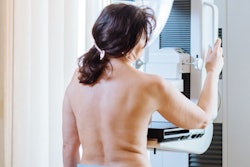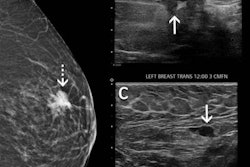
Could breast screening be made more efficient by targeting only high-risk women? Maybe, but a new study found that nearly 41% of breast cancers were detected by screening in women with no recorded risk factors, according to results published January 31 in the Breast.
A team led by Dr. Naomi Noguchi from the University of Sydney in Australia said their results do not support less frequent screening in women with no risk factors.
"The evidence we report in the present study will be relevant to breast screening programs contemplating evaluation of risk-based screening, as is being planned in several countries or indeed in trials in progress," Noguchi and colleagues wrote.
Risk-stratified breast screening has been looked at in recent years to make screening more efficient. For women at low risk of cancer, this could help reduce the harms of screening, such as radiation exposure or increased anxiety.
However, the study authors said little is known about screening outcomes in women who don't have any specific risk factors for breast cancer and who are deemed to be at or lower than population risk.
Noguchi et al explored the issue using data from the BreastScreen Western Australia (BSWA) program. Here, mammography screenings in women aged 40 years or older were collected between July 2007 and June 2017. These women were eligible for free mammograms every two years in the program. The data included 1,026,137 mammography screening episodes in 323,082 women.
The researchers found that 2,347 (40.9%) of the 566,948 screening exams in women with no recorded risk factors were positive for breast cancer. They also found that the cancer detection rate and interval cancer rate were lower than screening exams with at least one risk factor.
| Breast cancer rates for screening with no risk factors versus at least one risk factor | ||
| Screening exams with at least one risk factor | Screening exams with no recorded risk factors | |
| Cancer detection rate | 83 per 10,000 screens | 50 per 10,000 screens |
| Interval cancer rate | 12.2 per 10,000 women years | 7.9 per 10,000 women years |
The researchers also found that the interval cancer rate was lowest in screening exams of women with neither risk factors nor dense breasts in all age groups.
Similar cancer detection rates were seen across all age groups for timely screens with risk factors (under 27 months) and delayed screens with no risk factors (after 27 months). However, delayed screens with no risk factors had a higher proportion of node-positive cancers (26.1% vs. 20.7%).
The team wrote that while this may seem counterintuitive since these are different groups, these results "highlight the need for caution, or at least thorough evaluation, if longer screening intervals are contemplated as part of risk-stratified screening."
"The effect of delaying re-screening may be larger because some of the women with risk factors may have had a supplementary examination between routine screening outside of the public screening program," they added.
The team also wrote that this result means it's important for screening programs to support timely rescreening for women with risk factors, adding that a "remarkably high" interval cancer rate was seen in women with risk factors and dense breasts.




















